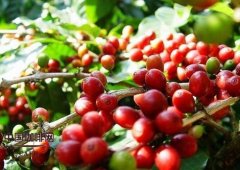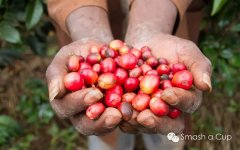Coffee in Asia what coffee beans are recommended to grow in Asia
Taiwan, China (China Taiwan) aroma 3.5 minutes brightness 3.5 minutes mellow 4 points flavor 4 points aftertaste 4 points
Suitable for baking: bake to deep baking in Full city/Espresso, drop beans before second explosion.
As a matter of fact, the cultivation of coffee in Taiwan has a long history. Both the British and the Japanese have planted coffee trees in Taiwan, but then they did not continue to promote it because of many political and economic factors. Until recently, because of the coffee boom, someone started to reinvest in it. Hebao Mountain in Yunlin Gukeng, Huisun Forest Farm in Nantou, and Dongshan Township in Tainan County are several famous coffee producing areas in Taiwan Province, and most of them are planted in Arabica. Taiwan coffee has a moderate flavor, low acidity and a hint of herbal flavor, similar to the synthesis of South American and Indonesian beans. At present, the output of coffee in Taiwan is not high, but because the popularity of coffee fever in Taiwan has caused many people to have a relationship with Fangze, the price has remained high, even using imports to pretend to be clear.
Papua New Guinea (Papua New Guinea) aroma 3.5 minutes brightness 3.5 minutes mellow 3.5 minutes flavor 4.5 points aftertaste 4 points
Suitable for baking: City/Full city New Guinea beans can be baked in a wide range, from soft and well-balanced city to full city with a well-balanced flavor, and even re-baking with oil, depending on your preference.
New Guinea is also an anomaly in Indonesian coffee. Coffee estates are numerous, large and small in scale, and most of the small estates produce washed organic beans with strong flavor but no local flavor. These small estates also produce a small amount of sun beans, which are more varied and delicate than water-washed beans; the taste of large manor coffee is more clean and delicate, but some people think that it has less personality. Basically, Babu coffee is lighter than java beans, somewhat similar to good Central American beans. Most of the coffee trees in the area come from the Tibica seed of the Jamaican Arabica bean, mixed with the Arabica bean from Tanzania. There are also some new hybrids or Indian Ken specialties.
India (India) aroma 3.5 minutes brightness 4 minutes mellow 4 minutes flavor 4.5 points aftertaste 4 points
Suitable for baking: Full city/Espresso full city, if you want to get a thick flavor like dark chocolate, you can even enter the dense area of the second explosion!
The taste of Indian coffee is very mild, very low in intensity and acidity, with some spice and, of course, the common local flavor of Asian beans. India is usually used to blend into Espresso recipes. In fact, Indian beans taste like Sulawesi beans or Sumatra beans, but not that thick. Indian coffee does not sell well in the international market, and the main markets are in India. Indian beans treated in the sun are called Cherry, Arabica beans washed in water are called Plantation Arabica, and Robusta in water are called Parchment Robusta. In addition, rainy beans and aged beans increase the consistency of coffee and dark chocolate-flavored aged beans. Coffee beans have also begun to amaze coffee critics in India this year, most of which come from independent coffee farms.
Important Notice :
前街咖啡 FrontStreet Coffee has moved to new addredd:
FrontStreet Coffee Address: 315,Donghua East Road,GuangZhou
Tel:020 38364473
- Prev

The most representative producing area of Sulawesi is Traga.
Sulawesi (Sulawesi) aroma 3.5 minutes brightness 4 mellow 4 flavor 4 aftertaste 4 points suitable for baking degree: City/Full city full city is the best to start the pot just before the second explosion. Because the color of Sulawesi is not dark when baking, it is easy to overdo it if you use color as the standard of baking. Sulawesi is also known as Cyberis, which is actually
- Next

Understanding the flavor of African coffee in coffee producing areas
Uganda (Uganda) aroma 3% brightness 4% mellow 4% flavor 4% aftertaste 4% suitable for baking degree: Full city / Espresso suggested to enter the second explosion, at this degree there will be a very obvious chocolate flavor, if baked a little deeper is quite suitable to be mixed into the Espresso formula. It takes a mature period after baking, so you will get the most complete taste after three or four days.
Related
- Beginners will see the "Coffee pull flower" guide!
- What is the difference between ice blog purified milk and ordinary milk coffee?
- Why is the Philippines the largest producer of crops in Liberia?
- For coffee extraction, should the fine powder be retained?
- How does extracted espresso fill pressed powder? How much strength does it take to press the powder?
- How to make jasmine cold extract coffee? Is the jasmine + latte good?
- Will this little toy really make the coffee taste better? How does Lily Drip affect coffee extraction?
- Will the action of slapping the filter cup also affect coffee extraction?
- What's the difference between powder-to-water ratio and powder-to-liquid ratio?
- What is the Ethiopian local species? What does it have to do with Heirloom native species?

